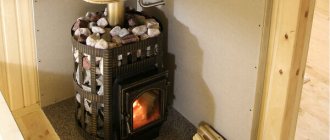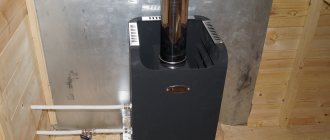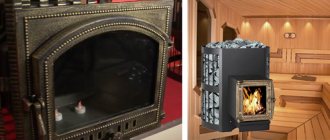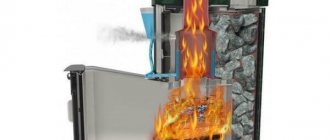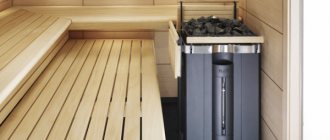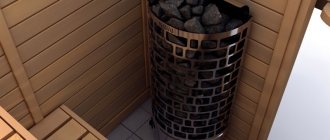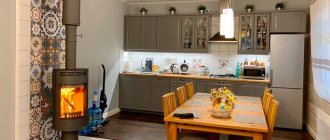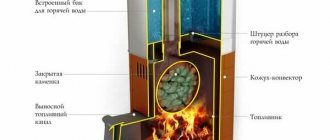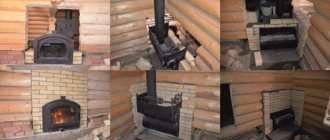What is an electric sauna stove
An electric sauna stove is a special device that generates heat from electric current, that is, converts electrical energy into thermal energy. At the same time, the structure is protected from humidity and water ingress.
According to the design, the heating element is a metal cabin with a spiral of wire with high resistivity. An example of such a wire is nichrome wire, which has a high resistivity with a low temperature coefficient. You can buy X20N80 nichrome wire on the website kmkstal.ru.
Heater device
Required tools and materials
A purchased electric sauna heater is reliable and durable. But it often happens that either the power of such a unit does not fit the specific design of the bathhouse, or the overall dimensions do not allow convenient placement of the heater in the steam room.
Electric heater with heating elements.
There is only one option left: to make the stove yourself. In order to make an electric sauna stove with your own hands, you will need a certain amount of materials and a small set of tools:
- electric heating elements;
- sheet metal (thickness of 3 mm or more);
- wiring;
- power regulator (rheostat);
- temperature sensor;
- electric welding;
- Bulgarian;
- asbestos;
- heat-resistant paint;
- stones.
Advantages and disadvantages of an electric sauna stove
advantages of an electric sauna stove can be highlighted :
- The main advantage of an electric sauna stove is its ease of installation. To install an electric stove, you do not need a foundation and a chimney, as for a wood-burning stove.
- As a result, the electric furnace does not require a pre-prepared special place in the steam room. The stove is placed in the finished steam room.
- An electric stove does not require special care: there is no need to clean the ash pan, remove ash, or prepare firewood.
- You can't get burned from an electric stove in a sauna, which is also important.
Related articles: Calculation of grounding of a private house
Disadvantages of an electric furnace
The main disadvantage of an electric furnace in a sauna is the mandatory presence of power supply and the additional electrical power generated.
Features and principle of operation
An electric oven is a device consisting of a housing, a thermal insulation layer and a heating element (usually a heating element) . In some cases, tape heaters may be used. They are much more durable, unlike heating elements, and do not burn oxygen as much.
There are also combined models, but their cost is much more expensive. On the outside of the case you can see special metal plates with channels for air circulation. The body itself is filled with stones. Steel screens, which are placed one after another, act as a thermal insulation layer.
This device operates from an electrical network of 220 Volts..
IMPORTANT!
The main condition for safe, normal operation is that the outlet must be installed in a dry place. That is why all models are equipped with a long cable that extends outside the steam room.
The principle of operation of such furnaces is simple: the heating element heats the stones inside the chamber, from which heat emanates . Due to this, such devices received the name “electric heater”.
The stove can be installed either on the floor or mounted into the wall. Many modern models can be mounted in both of these ways.
Most electric furnaces are designed for “dry” steam . If you add too much water to it, this can lead to breakdown of the heating elements. Therefore, many manufacturers equip their stove models with special steam generators, thanks to which you can achieve the “Russian bath” effect.
Calculation and installation of a stove in a sauna
There are electric ovens on sale that are designed to connect to 220 V and 380 V. The power of the ovens is from 3 kW.
For furnaces with a power of up to 4.5 kW, a 220 V power supply is required. For more powerful furnaces, a 380 V power supply will be required.
calculate the required power of an electric stove using a simple formula: to warm up 1 cubic meter of a wooden sauna you need 0.8 kW of stove power. For ceramic tiles you need 1.3 kW.
To increase safety, it is recommended to protect the walls and floor where the electric furnace is installed with non-combustible materials (ceramic tiles, sheet metal).
Be sure to raise the stove from the floor to the recommended distance. This is necessary for effective ventilation of the steam room.
It is imperative that a ventilation system is installed in the steam room. A hole for air intake is made under the stove 10-15 cm from the floor. The air outlet is made on the opposite wall from the stove, under the ceiling.
The electric oven is connected to a separate group of electrical wiring with protection of this group by a circuit breaker and a residual current device. Two devices can be replaced by one differential circuit breaker.
The rating of protective devices is selected according to the power of the electric furnace.
The furnace power cable is connected to the furnace control panel. This cable is made of copper, double or triple insulated with non-flammable (flame retardant) insulation.
The control panel is installed outside the steam room, usually at the entrance.
From the control panel to the furnace itself, a special cable with rubber heat-resistant insulation or RKGM wires is used.
Related articles: House made of SIP panels: general recommendations for construction
Calculation table for installing an electric stove in a sauna
Suitable types of cable or wire
Those who believe that the wire for a steam room in a bathhouse should be specific think correctly. Its main task is to withstand high temperatures. The PUE, as you remember, speaks of the upper limit of the range of 170 degrees.
You should find out this point when purchasing the cable in the store.
You need the following brands: PRKS and RKGM. The wire cross-section can be calculated based on the expected load.
Go to this article - there is a section calculation table. What are PRKS and RKGM? These are copper cables with silicone insulation that can withstand high temperatures.
PRKS can withstand a temperature range from -50 to 180 degrees with humidity up to 98% . The manufacturer himself recommends it for use in saunas and baths.
In principle, wires are included with the stoves, but it is worth keeping in mind that PRKS comes with different cross-sections, including those capable of withstanding up to 30 kW of load.
RKGM an outer fiberglass braid. Its characteristics are approximately the same: temperature range from -60 to 180, will withstand 100% humidity at temperatures up to 35 degrees , and is resistant to combustion.
As you can see, these are really suitable brands of cable for a steam room in a bathhouse.
Electrical wiring for electric furnace
Electrical wiring is carried out to power the electric furnace according to the rules for installing electrical wiring for wet rooms, namely:
The cross-section of the cable cores is selected according to the maximum power of the furnace;
To reduce the cost of electrical wiring, it is permissible to install an electrical box with IP protection from IP=54 a meter from the stove. To the box, make the wiring with a VVGng or NYUM copper cable, and from the box to the stove, make the wiring in metal corrugation or pipes with an expensive heat-resistant cable;
The through passage of cables through the walls is carried out in embedded non-flammable pipes, which are sealed with non-flammable solutions (materials). Electrical and control cables are laid separately.
Connecting equipment
Installation diagram of an electric floor oven.
The sauna stove is practically made with your own hands. All that remains is to connect it and check its functionality. It is very important to correctly calculate the power of the stove and select a power cable for it. The power of the stove is quite large, so the cable must be selected with a small margin. And the thickness of the core must be appropriate, the insulation must be reliable. The connection is made through a thermostat. If you mainly enjoy dry steam, the regulator can be installed directly in the steam room. But it is much safer to place this element in the dressing room. Then the version of the Russian bath will be safe for visitors to the steam room.
Don't forget to ground the heater body. It is important!
Now the basket needs to be filled tightly with stones. It should be remembered that the larger the total area of contact between the stones, the higher the heat transfer will be. It is advisable to use stones of flat shape and different sizes for the stove. Then you will have the opportunity to pack them in the basket as tightly as possible. Try to maximize the height of the stones, since the volume is also very important: the larger it is, the longer the high temperature will remain in the steam room.
Modern models of electric heaters
The appearance of modern electric sauna roasters amazes with the variety of design of the heating system and elegant design solutions of the body. Almost all models are made in a modern design, with beautiful shapes and contours, but this is not the main thing. The equipment operates on mains power, so it may pose a certain threat to people.
Reliability of the electric heater
Experts recommend paying attention to easy access to some parts of the electric heater:
- The temperature sensor on the heating elements burns out first, so you will have to change it several times, especially since even expensive branded models of sauna heaters have cheap Chinese heating sensors. The price of the product is at least 70 dollars;
- Device for monitoring the water level in the steam generator. You will have to monitor it and periodically check its operation, otherwise you can burn out the steam generator;
- Panel and remote control. They often fail due to improper storage and use. The device is not cheap; for some models the price for the control unit can reach $400.
In addition, you will need to regularly rinse the steam generator container and clean the stones from plaque. On average, full maintenance of an electric heater with a steam generator for a bath takes no more than 1-2 hours of time per year, so an electric stove is considered more convenient than a wood stove.
What do we pay attention to when choosing
If necessary, you can make an electric heater for a bath with your own hands, or look for a branded industrial model with a corner, central or wall location. The case is most often made of stainless steel or special zirconium enamel is applied. Paintwork for heaters is rarely used due to the high price of heat-resistant powder paints.
Advice! If the water used in the bath contains a lot of calcium salts, then it is best to choose an enameled model with a matte finish.
For amateurs, electric heaters are made with lining from the most popular bathing stone, chalcopyrite. It turns out very beautiful and at the same time reliable, since any broken fragment of the finish can be easily returned to its place using heat-resistant glue.
Electric sauna heaters can be divided into two groups according to heating method:
- Classic version with basket loading at the top of the body. This option is convenient in that the main flow of hot air is directed under the ceiling in a strictly vertical direction;
- Open electric heaters are used in baths with a large steam room volume. As a rule, they are installed on opposite sides of the sauna walls and adjusted so that the entrance to the room warms up more, and a stable temperature is maintained on the shelves.
The latter option is considered more effective, but less safe to use. In addition, you need to think about what are the best stones for this type of electric heater. If you don’t know what to choose, it’s best to order a special set of crushed calcite or chalcopyrite. As a last resort, you can use crushed light pebbles or pebbles of silicon-containing rocks as stones for an electric heater.
Advantages of using an electric heater
The main thing why an electrically heated device is valued and loved is the precise heating settings:
- With the help of a branded electric heater, you can manually gradually adjust the heating of the stone ballast and, accordingly, select the most comfortable temperature and air humidity in the steam room;
- Maintain certain aromas in the sauna air, change them to suit the tastes of visitors, and even treat with steam from herbal infusions;
- The process of controlling the “roll-up” of steam becomes relatively safe, without thermal shocks and burns, both for the bathhouse attendant and for ordinary bathhouse visitors.
For your information! With the help of an electric heater, it is quite possible to correct the shortcomings made during the construction of a sauna, to raise the heat in a cold and damp sauna to the level of a real Finnish sauna.
It is quite difficult to choose the right conventional wood-burning heater for a steam room; it is quite difficult to guess its location and power. Often it is necessary to insulate the walls in the bathhouse and add ventilation. Therefore, often, instead of fussing with construction, owners install a large wood-burning or coal stove in the bathhouse, most often a brick one with a fireplace, and for a steam room or hot sauna they install an electric heater.
Additional recommendations for the master
A do-it-yourself electric sauna heater can also be made to connect to a three-phase network.
But here all calculations must be made especially carefully in order to avoid excessive heating of the heating elements and their premature failure. Care must be taken when installing heating elements into a single electrical circuit. You definitely can’t do without some knowledge of electromechanics and electrical engineering. And if you don’t have such knowledge, then seek help from an experienced master.
Sometimes combined types of heaters are used in the interior of steam rooms. In addition to the electric stove, users install a brick wall finished with natural stone. This will increase heat transfer slightly, but additional safety measures will be required. You will need to lay a layer of thermal insulation between the load-bearing and imitation wall. This is important if the bathhouse is built using a large number of wooden elements (log house). For brick baths, there is no need for additional walls, since they only increase the percentage of heat losses.
What is an electric heater with a steam generator?
On the market of special equipment for a bath, there are a huge number of offers of electric heaters for every taste and color. There are designs with an additional fan that blows air through the hot stone. Many bathhouse owners like systems with drip addition of aromatic liquids, from beer to linden infusion. In order not to be distracted by the heating process, you can choose an electric heater model with remote control and programmable bath heating time.
Most often, for a small bathhouse, connoisseurs and connoisseurs of steam choose more advanced models equipped with a steam generator. The question often arises: why install a device in a steam room that produces a stream of hot water vapor, if you can get by with an ordinary electric fryer or, at worst, a wood-burning sauna stove.
The fashion for black-style bath procedures is long gone; only a few enthusiasts are able to fight the smoking and smoky stove in a Russian bath. Most owners prefer a comfortable stay in the steam room.
The steam generation system evenly distributes air heated to the required temperature, aromatized and saturated with hot water vapor, in the space of the sauna or bathhouse.
Essentially, a steam generator is a coil or closed circuit equipped with an external heater, for example, an electric coil or a ceramic element. A fan blows air through the heat exchanger while simultaneously supplying a precisely dosed amount of purified water. The output is perfectly pure steam without splashes of boiling water.
At the same time, an electric heater with a steam generator for a sauna is a good way to change the thermal conditions of the room. Instead of the dry, overheated atmosphere of a Finnish bathhouse, the generator will help make it stronger, richer in steam and less hot, like in a Russian bathhouse. Well, for lovers of oriental, Turkish or Roman baths, it is quite possible to control the electric heater with your own hands and choose a cooler, more gentle mode, as in thermal baths or hammams.
Which stones are best for an electric heater?
For an electric heater in a bathhouse, you cannot use stone backfill of any composition. Most rubble material, pebbles and even pebbles picked up on the beach are not suitable for rock backfill. They crack easily due to temperature changes during the steam generation process, produce a lot of fine rocky dust and often contain heavy metal compounds.
Bath stones must be dark, without colored veins or inclusions
The best option would be stones based on quartz or quartzite. The most expensive electric heaters are filled with fine crumbs of jadeite, chalcopyrite, you can even use the so-called fused stone specifically for lining hot areas of the bathhouse. An electric heater will require from 15 to 40 kg of stone, depending on the tank capacity.
